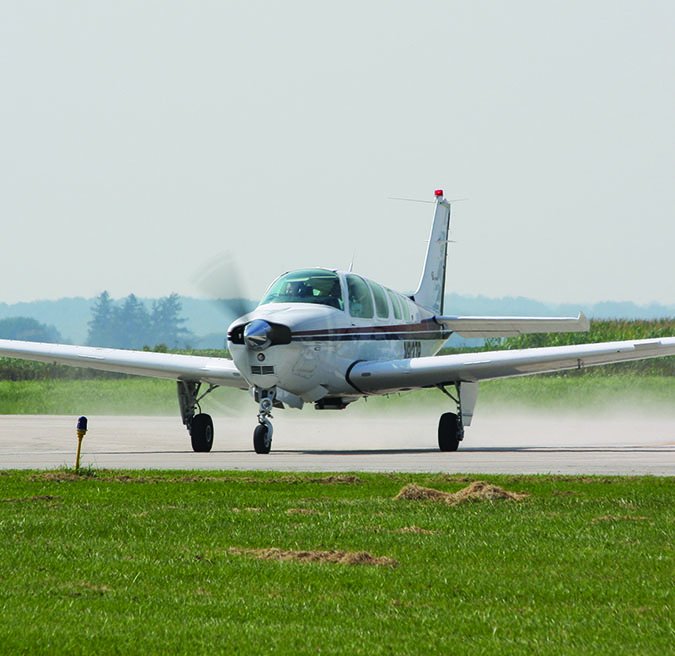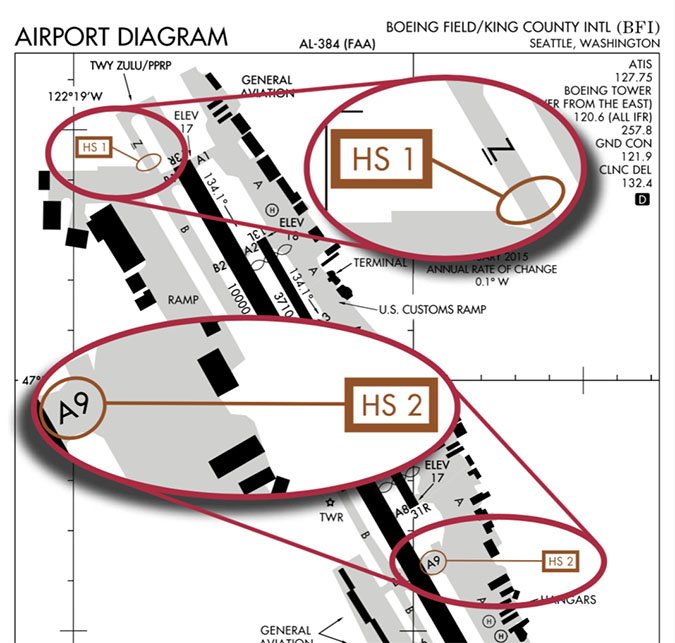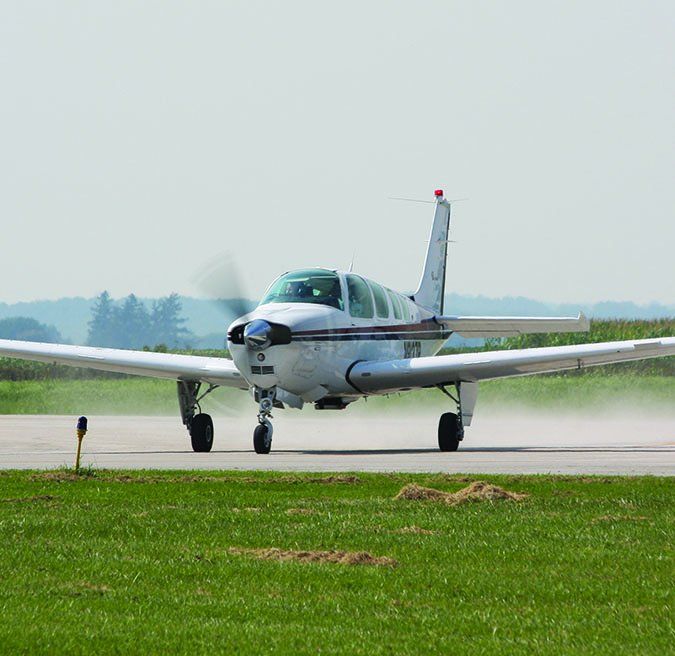D. Miller/Creative Commons
It was in the news recently: Noted actor and aviation proponent Harrison Ford, while arriving at an airport on the west coast, reportedly landed on a taxiway, not the assigned runway. Oops! Dissecting that event is not this article’s purpose. But it did get me to wonder: How often does this happen? Why does it happen? What can we as pilots do to minimize the opportunities for this type of event to happen to us?
So I did some research, one conclusion from which is we all are human and humans err, apparently in anything from a small two-seat single to Boeings, and everything in between. I went to NASA’s Aviation Safety Reporting System web site, asrs.arc.nasa.gov, and used the database search function to come up with a list of reports involving landings on taxiways. Let’s see what we can learn from a few selected reports.
Hotspots
September 2016: An airplane identified as a “Small Aircraft, High Wing, 1 Eng, Fixed Gear, Crew of 1, flying under FAR 91” landed on a taxiway at Boeing Field/King County International (KBFI) in Seattle, Wash. The report discussed the unfamiliarity of transient pilots with the intricacies of parallel taxiways and runways at Boeing Field. In reviewing the airport diagram, Boeing Field has several “hotspots” denoted (see the airport diagram on the opposite page). What is a hotspot? Why do you care?
The FAA defines a hotspot as “a runway safety-related problem area or intersection on an airport. Typically it is a complex or confusing taxiway/taxiway or taxiway/runway intersection.” The FAA has seen a history of errors at that particular location on that particular airport and they want to warn you. If other pilots have made mistakes at that intersection, chances are you will too, unless you are vigilant. Hence the hotspot. Yes, you can get burned there.

Last minute requests
June 2016: A Beech King Air was cleared to land at an unspecified tower-controlled airport. The pilot was on an IFR clearance and accepted a visual approach. The controller asked him to fly across the final approach course and then rejoin (a modified S-turn is how the pilot described it) to increase separation between the King Air and another aircraft landing on another, intersecting runway. The pilot accepted the request and did so. He thought he had reacquired the runway in use, but actually lined up and landed on the parallel taxiway. Thankfully, no other aircraft was on that taxiway so the landing and roll out were embarrassing, yet uneventful.
I will assume all of us want to be good pilots and helpful to others, but sometimes that can be a bad decision, a recipe for a mishap. The pilot of the King Air most likely was set up for a straight-in instrument approach, and had he maintained that with an instrument back-up (an ILS, localizer or GPS procedure), lining up visually to a taxiway probably would not have occurred. But in his desire to help, he lost his setup to the runway, and tried to reacquire it, obviously unsuccessfully.
Be aware in your flying that giving up a known (a line up to a runway, with a navigational aid to help) for an unknown (a modified S-turn that causes you to lose your alignment to the runway) can have a very different ending than expected. The one word that we as pilots hate to use is the word “unable” when talking to ATC. Yet it is okay to do so. Maybe if this pilot had said he was unable to safely make the S-turn, ATC could have figured a different way to keep the two airplanes safely separated.
Field Conditions
March 2016: An instructor and student were flying in a single-engine airplane to the David Wayne Hooks Airport, in the Houston, Texas, area. It was near dusk. Recent heavy rains had closed one runway, and lights were inoperative at the field due to the rains.
The instructor and student were advised by the tower of the runway in use, and reminded of the closed runway. No mention was made in the narrative of whether the inoperative lights were discussed, although it most likely was in the Notams for that airport. (You do review the Notams anytime you fly, even at your home airport, right? I thought so.) The instructor and student lined up for and landed on a taxiway between the two parallel runways.
Any time you fly, even when everything is normal—the weather is great, all runways are open, all lights are operative, etc.—things can go wrong. But when anything is abnormal—closed runways, no lighting—that’s when your “what could possibly go wrong” radar should be turned up full blast. Things can go wrong quickly, so be aware and stay extra cautious.
At Your Own Risk
October 2012: A Piper PA-28 was flying into Montgomery Field, near San Diego, Calif., VFR at night. The pilot contacted SoCal Approach due to his inability to acquire the airport visually. He apparently was disoriented, and had turned north, away from the airport. The aircraft was vectored back toward the airport and handed off to the tower. The pilot was told that he was landing “at your own risk” on Runway 28L. Runway 28R was closed for repairs, yet it was the only runway at the time with operable runway edge lights. Runway 28L had no edge lights, only REILs (runway end identifier lights), which were on at the time. The pilot lined up and landed on a parallel taxiway.
What kind of landing clearance is “at your own risk?” Have you ever been told that by a controller? If you do hear that phrase, wake up! Those little hairs on the back of your neck should be raised, as that nice controller is giving you a warning (as well as covering himself/herself should things not go well). It is vitally important to understand that when those words are used, it is not a landing clearance.
I am not saying to never land if a controller uses those words. Every time we land at an uncontrolled field it is at our own risk, and we all accept that. What the controller is saying is you are planning to do something—i.e., land in a location where ATC cannot confirm the condition of the surface, or see you land—so they are not accepting responsibility for keeping you clear of people and things. Be extra vigilant when those words are used.
Fatigue and illness
October 2009: A Boeing 767 was returning from a long, all-night, backside-of-the-clock international flight. The flight required an additional pilot because it was scheduled for in excess of eight hours. During the flight, one of the three pilots became incapacitated by illness, so the two remaining pilots flew the entire flight with no crew rest.
In addition to being fatigued, ATC gave the crew a number of runway changes during the 767’s approach, requiring numerous inputs to the flight management system. While on approach to Runway 27L, the crew was offered a side-step to land on Runway 27R. The crew was not aware the Runway 27R approach lights and the ILS were inoperative when they accepted what appeared to be a simple shift to another parallel runway. Instead, they landed on a parallel taxiway.
Later it was determined the blue LED lights on the parallel taxiway actually appeared white from the air, providing the crew a miscue. There were other lights providing what appeared from the air to be runway centerline lighting.
Sick and tired is no time for a runway shift. I am sure that, in retrospect, these pilots wish they had stayed with the runway for which they had finally set up. Side-stepping in visual conditions to a parallel runway seems simple, yet it wasn’t in this case. If you find yourself flying and you are sick, tired or you just did not bring your A game with you, keep it simple with ATC. If they unintentionally overload you, tell them so. They really are there to help you, not to help set you up for failure.
Those Who Have and Will
I hope that in reading this you understand that I know that I am not throwing stones from my glass house. There, but for the Grace of God, go I. In fact, landing on the wrong runway is a lot like landing gear-up: There are those who have and those who will. What I hope I have done is point out some things to think about the next time you fly so you can avoid writing similar reports.
And to expand the discussion a bit, in addition to incorrect landings at airports of intended landing, I wondered how often the events of this type involves landing at the wrong airport. But let’s save that for another issue.
Terry Hand is a former U.S. Marine Corps helicopter and instructor pilot. His current day job for a major airline requires a type rating in the Boeing 757/767.




